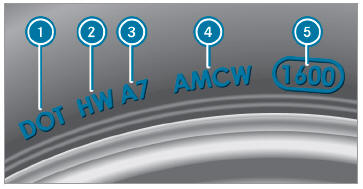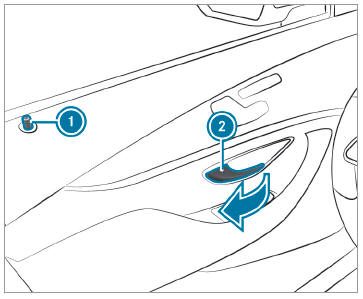Mercedes-Benz GLC 2016-2025 Owners Manual / Wheels and tires / Tire labeling / DOT, Tire Identification Number (TIN)
Mercedes-Benz GLC : Tire labeling / DOT, Tire Identification Number (TIN)
US tire regulations stipulate that every tire manufacturer or retreader must imprint a TIN in or on the side wall of each tire produced.

The data shown in the image is example data.
The TIN is a unique identification number to identify tires and comprises the following:
- DOT (Department of Transportation): tire
symbol marks
 indicating that
the tire
complies with the requirements of the US
Department of Transportation.
indicating that
the tire
complies with the requirements of the US
Department of Transportation. - Manufacturer identification code: manufacturer
identification code
 contains
details of the tire manufacturer. New tires
have a code with two symbols. Retreaded
tires have a code with four symbols. Further
information on retreaded tires.
contains
details of the tire manufacturer. New tires
have a code with two symbols. Retreaded
tires have a code with four symbols. Further
information on retreaded tires. - Tire size: identifier
 describes the tire
size.
describes the tire
size. - Tire type code: tire type code
 can be
used by the manufacturer as a code to
describe specific characteristics of the tire.
can be
used by the manufacturer as a code to
describe specific characteristics of the tire. - Manufacturing date: manufacturing date
 provides information about the
age of a
tire. The 1st and 2nd positions represent the
calendar week and the 3rd and 4th positions
state the year of manufacture (e.g. "3208"
represents the 32nd week of 2008).
provides information about the
age of a
tire. The 1st and 2nd positions represent the
calendar week and the 3rd and 4th positions
state the year of manufacture (e.g. "3208"
represents the 32nd week of 2008).
 Tire Quality Grading
Tire Quality Grading
In accordance with the US Department of Transportation's
"Uniform Tire Quality Grading Standards",
tire manufacturers are required to grade
their tires on the basis of the following three performance
factors:
Tread wear grade
Traction grade
Temperature grade
The data shown in the illustration is example
data...
 Information on the maximum tire load
Information on the maximum tire load
The data shown in the image is example
data.
Maximum tire load is the
maximum permissible
weight for which the tire is approved.
Do not overload the tires by exceeding the specified
load limit...
Other information:
Mercedes-Benz GLC 2016-2025 Owners Manual: Limitations of the protection provided by the seat belt
WARNING Risk of injury or death due to an incorrect seat position The seat belt does not offer the intended level of protection if you have not moved the seat backrest to an almost vertical position. In particular, you could slip beneath the seatbelt and become injured...
Mercedes-Benz GLC 2016-2025 Owners Manual: Music and sport alerts
Multimedia system: Radio SiriusXM Alerts Setting music and sport alerts This function enables you to program an alert for your favorite artists, tracks or sporting events. Music alerts can be saved whilst a track is being played and sport alerts can be saved during a live game...
Copyright © 2025 www.meglc.net


 To unlock and open a front
door: pull door
handle
To unlock and open a front
door: pull door
handle  .
.